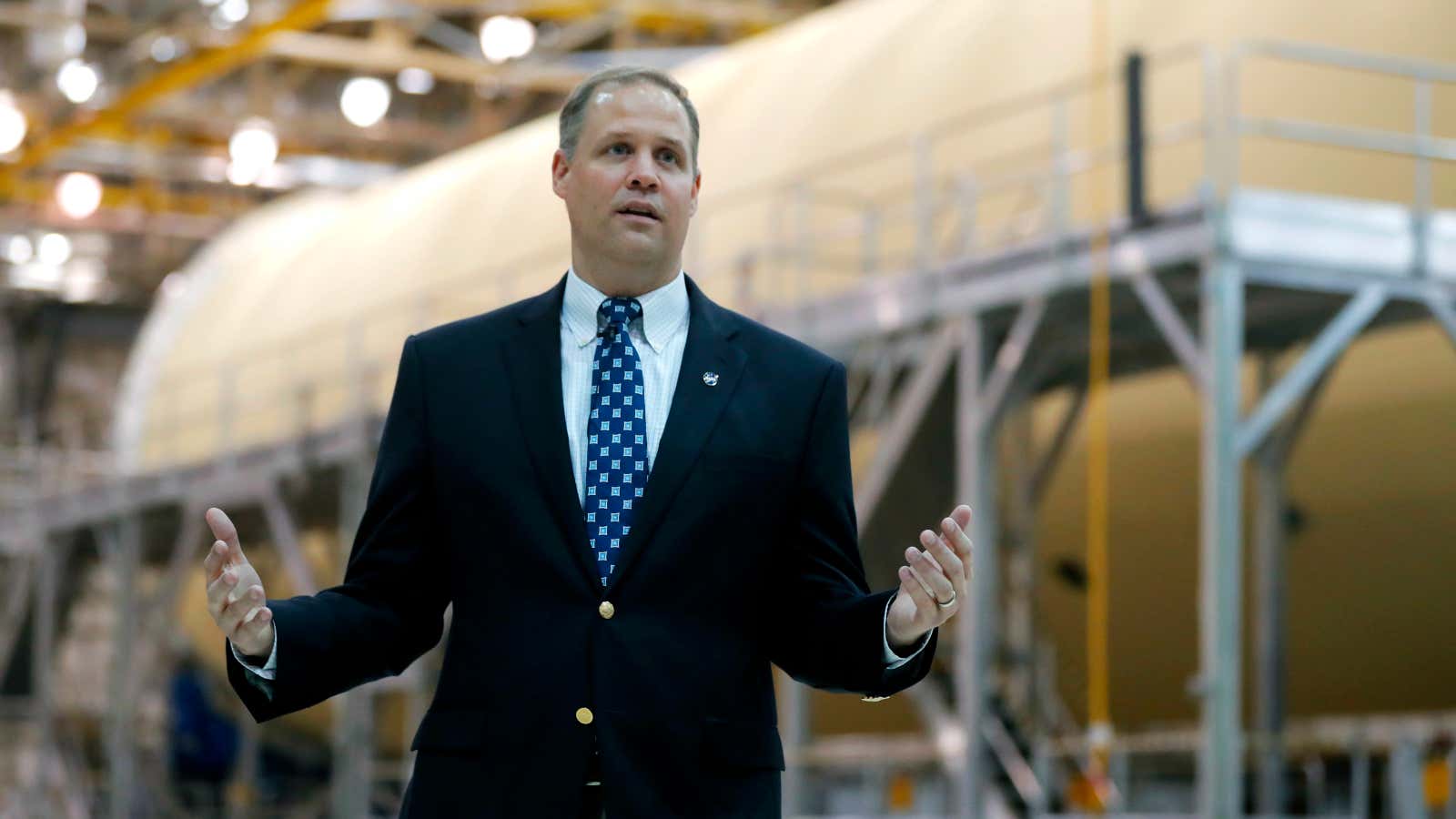NASA administrator Jim Bridenstine said his plans for deep-space exploration are not going to wait for a hugely expensive rocket being built under contract by Boeing.
In a hearing on NASA’s exploration plans today (March 13), Bridenstine said his agency would consider using privately designed rockets to avoid delays to an exploration mission, called EM-1, that will launch a new spacecraft called Orion on an uncrewed mission around the moon. So far, NASA has spent $14 billion on the yet-to-fly rocket, called the Space Launch System.
This is the first time NASA has conceded that it can accomplish its exploration goals without SLS, intended to be the largest rocket ever built.
“We as an agency need to stick to our commitments,” Bridenstine said. “I think we should launch around the moon in June of 2020… Here’s the glory of the United States of America. We have an amazing capability that we can use right now, off the shelf, in order to accomplish this objective.”
The decision to look at other rockets is a warning for Boeing and the NASA managers of the program that the SLS, long insulated from accountability by political patronage, needs to get back on track. It also means NASA could choose SpaceX’s Falcon Heavy rocket, or new rockets being developed by Jeff Bezos’s space company Blue Origin and the Boeing-Lockheed Martin joint venture United Launch Alliance, for the mission. ULA also operates a large rocket, Delta IV, but it is being phased out of production.
“[It’s] not a war, just a shot across the bow to get SLS in order,” one NASA official, not authorized to speak to the press, told Quartz of the rethink. In October 2018, NASA’s Inspector General found the project (pdf) was $4 billion over-budget and 2.5 years behind schedule, and reported that NASA did not understand the costs involved and was overly generous in awarding incentive fees to Boeing.
President Donald Trump’s budget proposal for NASA, released on March 11 (pdf), canceled planned spending on future upgrades to the still-unbuilt rocket until the first version is completed, another implicit criticism of the program.
Senator Richard Shelby, whose state of Alabama is home to much of the work on SLS, recently told the director of the NASA center developing the SLS that “you keep doing what you’re doing. We’ll keep funding you,” which sums up the approach to managing the project so far. Congress, which has largely ignored Trump’s proposed NASA budgets, will have the final say on this—but now there is a full-time administrator working to build a consensus between the White House and lawmakers.
Bridenstine said the decision to explore commercial options came after he was informed last week that the SLS would not be ready in time for next year’s proposed mission. The US space agency has been working on the project since 2008, and arguably since 2004, and it is expected to cost double the original estimate. But Trump has ordered NASA to return to the moon, and to do so, Bridenstine must wring as much value from partnerships with private companies as he can.
SpaceX and Boeing, which are also competing to fly astronauts to the International Space Station, have long had a rivalry over deep-space rockets. Boeing CEO Dennis Muilenberg has publicly proclaimed that his team will beat Elon Musk to Mars, with Musk replying, “Do it.” Today’s statement from Bridenstine shows Boeing is far from backing up the boast.
With the first launch of SpaceX’s reusable Falcon Heavy rocket last year, the US suddenly had access to a vehicle that could lift about two-thirds of what SLS can, but for about a tenth of the cost. Space engineers have argued that it would make sense to use those available rockets or others like them to launch the gear needed for deep-space missions in stages, rather than wait for the larger vehicle.
For example, EM-1 will launch the Orion crew capsule, built by Lockheed Martin, and the European Service Module, built by Airbus, which combine to create a vehicle that can safely carry astronauts far beyond orbit. Only the SLS is powerful enough to launch the two to the moon together, but they could be launched to orbit on separate rockets, dock together, and then proceed to the moon.
Bridenstine conceded that planning for this kind of docking maneuver will still be hard to do in just over a year, but suggested that it was more likely than seeing the SLS get back on schedule. And, though Bridenstine is a long-time advocate for relying on the commercial market at the space agency, he did say that the SLS is “critical” to future US deep-space exploration.
Now, the enormous, expensive rocket system will have to prove it.
